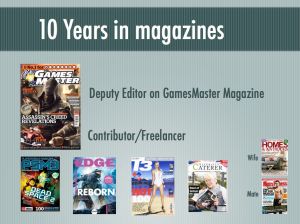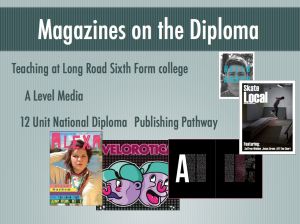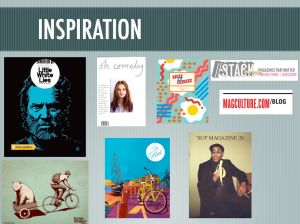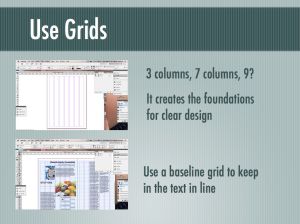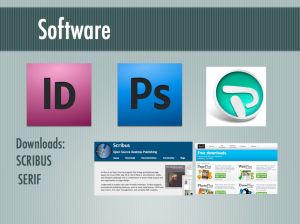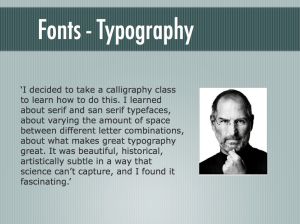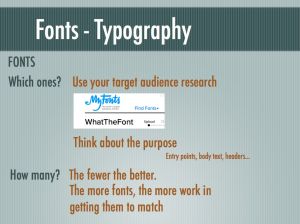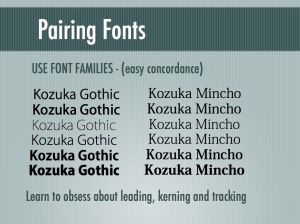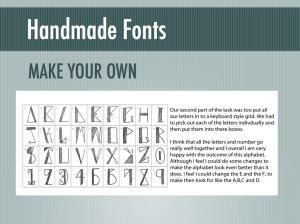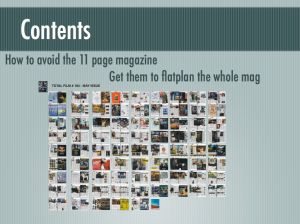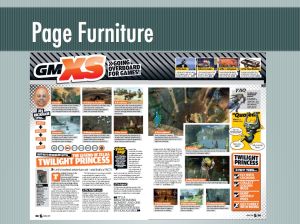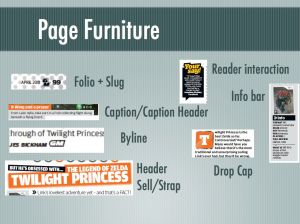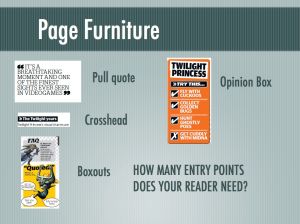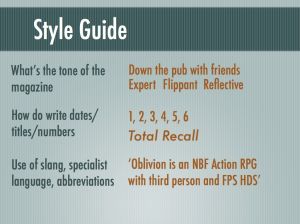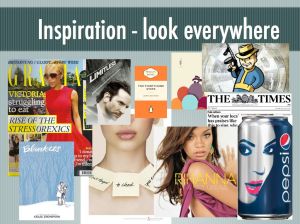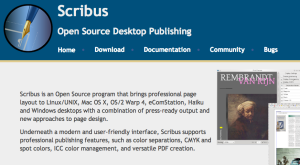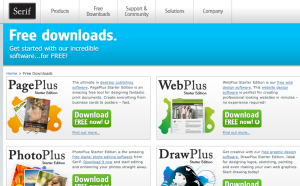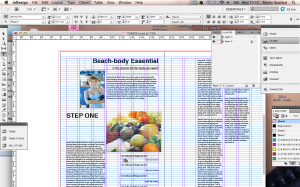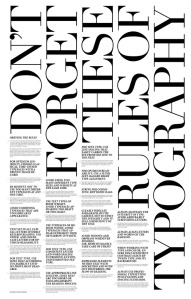DREAM BIG STYLISH DREAMS
Less of this
More of this
WORKSHOP WORKSHEET
SOFTWARE
USING GRIDS
Using grids when designing can be a massive help when trying to establish some coherence to the page and an identifiable structure. Once the foundations are established then anything that breaks the structure will stand out more and have more of an impact. Here’s a very simple look at the use of a 3 column grid but a good exercise is placing tracing paper over a magazine page and trying to figure out what grid they are using – 3 columns, 6? 7? 9? Then look at how this columns have informed the layout.
Here’s some advice on how to set up grids for InDesign, Photoshop and Microsoft Publisher.
RESEARCHING TARGET AUDIENCE FOR EXISTING PRODUCTS
Audience research is alway a tricky part of the creative process as often students don’t have the time, skills or resources to do it thoroughly. A quick way of doing it for established magazines is to simply look at the type of adverts that have – this should be (if the media buyers are doing their jobs correctly) representative in terms of brands, hobbies, media consumption of their readership.
This is what we did to build a readership profile for Total Film and Little White Lies.
AUDIENCE RESEARCH
The world of magazines is changing rapidly and what were powerful big selling brands now represent niche markets. With this in mind it might be worth students creating very magazines for very specific audiences – so for music magazines focusing on a certain genre or sub-genre of music.
If students choose this path they must go anthropological on the research to really lift the lid on the culture they’re attempting to represent.
Here’s some guidance for research.
ORIGINS
All music genres grow and develop from other types of music genres as musicians blend different styles and influences together. So where does your genre come from – which styles is it melding?
Who is seen as the main practitioner? Who are the main influences? Does the genre come from a certain scene/place/time?
When you’re researching this think about how all these influences work together – do the various musical influences affect the style/fashion/iconography of the genre? Does it influence what sort of audience it attracts?
Tips: Start at Wikipedia – use the references down below
Look on google videos – are there any relevant documentaries about the genre?
Have a look at this amazing Guardian Music Timeline.
FASHION
Is there a certain look to the genre in terms of clothes? How can you describe it? Why do they dress this way? Are there any key influences? Are there any key labels? Is it a DIY culture? Is the music used to advertise certain brands?
Tips: collect images of fans and bands of the genre – line them up and look for common threads and themes?
COMMUNITIES
Are there any key scenes for the music (for instance is there an acknowledge capital of the genre (think Seattle for Grunge, London for grime etc). Why do you think this is the case?
How do fans communicate – is it a local scene? Is it a global scene – do fans have specific websites? Which ones are they What makes them different?
Are there Facebook and Myspace pages? What sort of people are fans of this?
Tips: Look at the Myspace pages for the bands – look at the sort of people who are fans of this – what do their myspaces look like? Are there key colours, images, interests? Is there a certain language that they use? Are there common references? Are there any clues to types of films/comic/books/tv they are into?
TV AND FILM
Are there any films that use this type of music as its soundtrack? Are there any practitioners of the genre that act? Find them – look at the trailers and clips – is there a theme/content/style that is relevant to the genre?
Where are fans of the this genre represented on TV and film? (for instance, the main characters of Juno all like folky-indie stuff, is there film where they all are like R’n’B or Britpop or Pop Punk)? What do they look like? What are the stories about?
Tips: look for the key artists on imdb.com where do they show up? Is this any use? Is the film influenced by the style of music? Is it a mainstream film? Is the film designed to attract fans of the genre?
RADIO AND TV STATIONS
If you want to hear the genre of music, where do you go? Where is it visible? Are there key radio shows or stations, or TV channels? If so look them up – how are they marketed? What images/fonts/iconography are used? What colours? What sounds? What references?
Who are the key personalities promoting this music? How do they represent themselves? What interests do they have?
MAGAZINES & FANZINES
Where do you read about this genre or find out about new artists?
Tips: look for links off fansites? Type in specific searches in google – search creatively.
CLUB NIGHTS & GIGS
Are there key (or even local) club nights that play this music? How are they marketed? What are the called? What sort of venue do they use? What sort of people go? What sort of stuff do they wear/drink/talk about?
Are there key festivals? How are they promoted?
Tips: Look for official sites – take screen shots of the web pages – look at the images and the set lists.
LABELS
Are there key brands associated with the genre? Clothes, shoes, drinks, snacks, hair products, hats, anything?
ACTIVITIES & LIFESTYLE
Is the genre all about good living? Partying? Being political? Angst? Productive? Silly? Creative? Being active? Being rich? Being poor? Being angry? (A lot this can be seen in the videos)
TECHNOLOGIES
Are there key technologies – either in the music (electronic instruments – think autotune for current r’n’b and pop) or related to the lifestyle.
Tips: Read reviews about music, look for tutorials about how to replicate the sound, look at the videos and at the mise-en-scene.)
The pdf attached is a Brand Eye – it’s a way of piecing together and visualising the various qualities and values that your magazine has.
At the heart is the CORE PROPOSITION which is a simple statement of what your magazine stands for.
For GamesMaster this was simply “We love games”.
The BRAND PERSONALITY was ‘Passionate’ ‘Funny’ ‘Value for money’ ‘Entertaining’ ‘Friendly’
The TARGET READERS were ‘Game Fans’ ‘New owners’ ‘Multi-format owners’
SAYS ABOUT YOU referred to the reader – what does reading that mag suggest: ‘I need to know more’ ‘I want value for money’, ‘I don’t wrong to buy the wrong thing’.
MAKES YOU FEEL – again this is from the readers point of view ‘part of club’, ‘excited about games’, ‘clued-up’,
WHAT YOU PERCEIVE – what the reader believes is right about the mag: ‘unbiased opinion’, ‘contains the right games’, ‘Reviews I can trust’
BENEFITS TO YOU – ‘know more than my mates’, ‘experience games I don’t own’, ‘save money by buying the best games’.
It’s an interesting exercise for students to complete this to really think about what the brand of the magazine stands for and just why consumers should spend money on it.
FONTS
Choosing fonts:
Here’s an interesting article on pairing – it’s primarily for web fonts but it’ll start to get the students to think about certain ideas.
This from Smashing Magazine talk about the thought process behind choosing fonts in terms of functionality – so what is their main purpose. It will also get you thinking about X heights and setting the right tone and mood.
What the Font is a interesting if not necessarily fool proof way of trying to figure out what a certain font is. And dafont.com is good place to discover new and interesting stuff.
ilovetypography.com is a great site for nerdy out on typography and has some guidance on creating your own font.
Use Font Families for variation as they are designed to work together – choose the right font and you’ll be amazes at the amount of variety.

